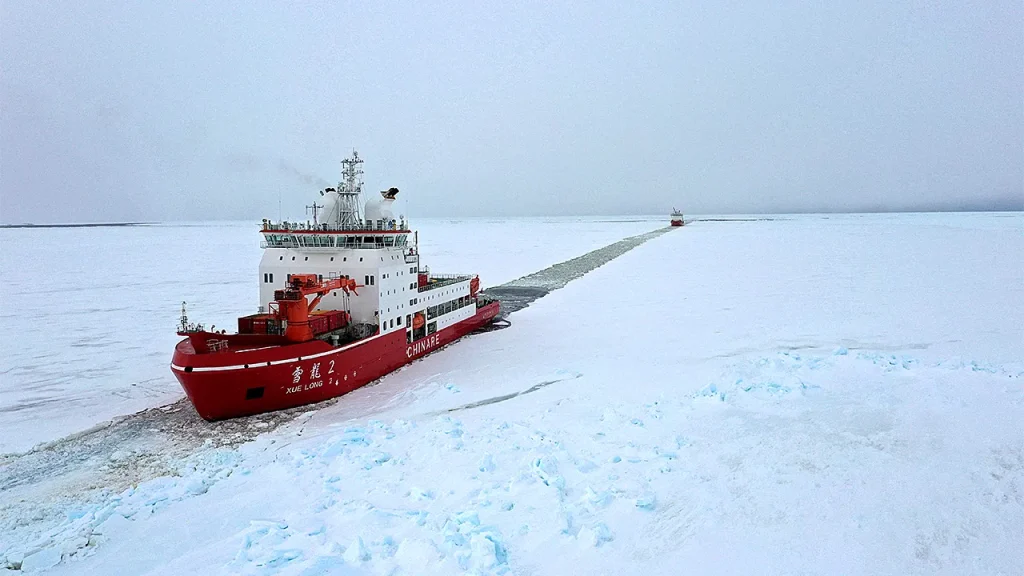U.S. Turns to Finland to Bolster Arctic Presence Amid Growing Competition
As the Arctic landscape transforms with melting ice caps, the United States is taking significant steps to address its longstanding icebreaker deficit. In a move that underscores the growing strategic importance of polar regions, President Trump and Finnish President Alexander Stubb recently signed a $6.1 billion agreement for Finland to provide up to four new icebreakers to the U.S. This partnership with Finland, a world leader in polar vessel technology and a new NATO ally, represents more than just an equipment purchase—it signals America’s renewed commitment to securing its interests in a rapidly changing Arctic environment where Russia and China have been steadily expanding their presence and capabilities.
The urgency behind this acquisition becomes clear when comparing fleet numbers: while the U.S. currently operates just three aging icebreakers—the 48-year-old Polar Star, the medium icebreaker Healy, and the newly acquired Cutter Storis—Russia maintains a formidable fleet of more than 40 icebreakers, including nuclear-powered vessels that can operate year-round in the harshest conditions. This “icebreaker gap” has placed the United States at a disadvantage in a region that defense officials now characterize as the front line of homeland defense, where critical early-warning systems, missile detection networks, and undersea communications infrastructure overlap with increasing Russian and Chinese military activities. The Coast Guard has been clear about its operational requirements, stating that at least eight polar icebreakers are needed to adequately meet America’s strategic and logistical needs in Arctic and Antarctic waters.
The Finnish deal is part of a broader collaborative effort known as the ICE Pact—an agreement between the U.S., Canada, and Finland aimed at accelerating icebreaker construction, sharing specialized technology, and strengthening allied operations in polar environments. This partnership comes at a critical time as the Arctic’s geopolitical significance continues to grow. The U.S. Coast Guard Cutter Storis recently completed a 112-day mission monitoring Chinese research vessels in Arctic waters, highlighting the increasing surveillance requirements in a region where Russia and China have been conducting joint naval drills in the Bering Sea near Alaska. These developments point to a shifting security landscape in which America’s limited icebreaking capability has hampered its ability to maintain continuous presence and respond to emerging challenges in polar regions.
Russia’s strategic objectives in the Arctic are particularly concerning to U.S. security planners. Moscow has been systematically militarizing its Arctic territories, deploying advanced air defenses, naval assets, missile systems, radar installations, and anti-submarine capabilities to forward bases along its northern coastline. A central Russian goal is to solidify control over the Northern Sea Route—an increasingly navigable maritime pathway along Russia’s northern shores that connects Europe to Asia and could significantly reduce shipping times between major global markets. Russia’s naval nuclear deterrent, especially its ballistic missile submarines, relies on Arctic sea lanes for stealthy deployment, making any Western presence in the region a matter of acute sensitivity for Moscow. This security dynamic, coupled with the Arctic’s wealth of natural resources, has transformed what was once a peripheral region into a central arena of great power competition.
The resource dimension of Arctic competition cannot be overstated. The region contains vast reserves of hydrocarbons, minerals, and rare earth elements—critical materials that all major powers seek to secure for their economic and industrial futures. China, though not geographically an Arctic nation, has declared itself a “near-Arctic” power and is actively working to establish itself as a legitimate stakeholder in Arctic governance and development. Beijing has integrated the Arctic into its global Belt and Road Initiative through the concept of a “Polar Silk Road”—a proposed maritime route over the Arctic that would connect China to European markets while bypassing traditional sea lanes. China’s particular interest in Arctic resources is strategic, as it currently dominates global supply chains for rare earth elements and minerals that are essential to advanced technology manufacturing, renewable energy systems, and defense applications.
This Finnish icebreaker agreement represents a significant step in America’s efforts to reestablish itself as a credible Arctic power, but experts emphasize that it must be part of a comprehensive strategy that includes infrastructure development, enhanced surveillance capabilities, and stronger diplomatic engagement with Arctic allies. As climate change continues to alter the physical landscape of the polar regions, opening new shipping routes and resource extraction possibilities, the competition for influence and advantage will only intensify. The U.S. Coast Guard’s domestic icebreaking fleet—which includes 21 vessels designed for clearing commercial shipping channels in waterways like the Great Lakes and 16 ice-capable buoy tenders—serves important functions but lacks the capabilities needed for prolonged Arctic operations or power projection in contested polar environments. The acquisition of Finnish-built icebreakers addresses an immediate capability gap, but sustaining American influence in this increasingly strategic region will require long-term investment, innovation, and international cooperation to ensure that the Arctic remains a space governed by rules-based order rather than unilateral assertions of power.















